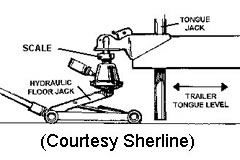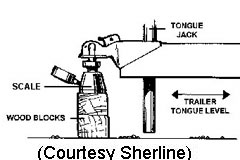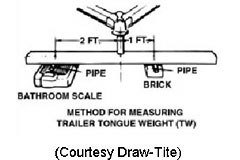Trailering is serious business. Done wrong, it can lead to poor handling, expensive damage or a serious accident. One of the most important considerations is proper weight and balance. Here are some tips to assure trailering is always a pleasant experience.
If you are buying a new tow vehicle, give as much attention to its towing capacity as you do to the engine or amenities inside. If you already have a trailer, a new tow vehicle should have the capability to pull it without taxing its engine, suspension or brakes. Likewise if you already have the tow vehicle, do not pull more trailer than your vehicle can handle. Upgrading a vehicle to pull more is not an easy or inexpensive task.
The easy way to see if the actual weights exceeds the rating is to weigh it on a truck scale. Weigh the tow vehicle alone, but with the trailer attached and off the scale for comparison with the Gross Vehicle Weight Rating (GVWR). Weigh both tow vehicle and trailer together for the Gross Combined Weight Rating (GCWR). If the scale is not large enough, weigh each separately and add together. For the Gross Axle Weight Rating (GAWR), weigh the vehicle with one axle on the scale at a time. Weigh the trailer alone to find the Gross Trailer Weight (GTW). Either weigh with passengers and cargo onboard, or add the expected weight of people and cargo you will be carrying to the "empty" vehicle. Weigh with a full fuel tanks or add six pounds for each gallon of fuel.


Determine the tongue weight using a “tongue” scale or just an ordinary bathroom scale. Or you can pull the trailer onto the scale and leave the tow vehicle off the scale. Then "unload" the trailer from the tow vehicle by jacking up the front of the trailer so the coupler is completely off the hitch ball and weigh. Then "load" the tow vehicle by connecting the coupler and weigh again. The difference is the tongue weight.

The allowable tongue weight, usually expressed as a percent of the GTWR, depends on the type of trailer. For a single or tandem axle trailer, the tongue weight should be between 10% and 15% of the GTWR. For a fifth-wheel setup, the tongue weight can go up to 15% to 25% of the loaded trailer weight. And what if tongue weights are outside these limits? Less results in a tendency to lift the rear of the tow vehicle resulting in loss of rear wheel traction. Over leads to excessive weight placed on the vehicle which can damage the drivetrain and suspension as well as result in poor handling due to an unfavorable front/rear weight distribution for the tow vehicle.
Hitch ratings are based on the GTWR:
- Class I (up to 2000 pounds)
- Class II (2000 - 3500 pounds)
- Class III (3500 - 5000 pounds)
- Class IV (5000 - 8000 pounds)
- Class V (8000 - 10,000 pounds).
Often Class IV and V are combined extend Class IV to 10,000 pounds. Fifth wheel hitches are rated between 12,000 and 22,000 pounds while a gooseneck ball hitch is typically rated at 25,000 pounds. Do not exceed these ratings which are usually marked on the hitch itself..
A weight-distributing, or equalizing, hitch can minimize the load placed on the tow vehicle's rear suspension and maintain a level rig. This hitch also allows a greater tongue weight and thus a greater trailer weight. For example, with an weight-distributing hitch, the maximum GTWR for a Class III or IV hitch doubles to 10,000 and Class V is increased to up to 14,000 pounds. While weight distributing hitches can increase capacity safely, be sure it is selected and installed properly. Done wrong, they can reduce the load on the rear wheels of the tow vehicle decreasing traction. Finally, these hitches cannot overcome an inadequate tow vehicle nor an overloaded or improperly loaded trailer.



Even though it might not seem to effect handling, overloading can eventually come back and bite you. The excess load can stress your tow vehicle’s or trailer’s frame, suspension, brakes, bearings, tires and even the drivetrain till something breaks. Excessive loading can also cause hitch failures.

Make sure items in the trailer are tied down especially the big, heavy stuff. A shifting load can be worse than an overload. Once you have the heavy items secured, measure the tongue weight. If off by a large amount, shift items around to correct things. However, shifting things around can’t compensate for a tow vehicle or hitch that can’t handle the load. Also you can load small things to achieve the right balance, but note that a lot of little stuff can add up to a lot of weight and should be secured to keep in place.

Pay attention to side-to-side weight distribution as well as front-to-rear distribution. If one side is loaded more heavily, it can cause difficulties when turning, even result in the trailer flipping over uring a sudden turn or lane change. Avoid top heavy loading that can result in problems when turning or the trailer diving when braking hard. Diving increases tongue weight leading to reduced loading on the front axle. This happens suddenly and when accurate steering and strong front braking is needed most.

Whether buying a new tow vehicle or trailer, or just loading up for a trip don’t load to maximum capacity. Beside leaving capacity for all those purchases you might make before you get home, you need a certain margin of safety to handle more demanding driving situations. For example, when you hit a bump or dip in the road, the hitch, as well as everything else, is subjected to a sudden increase in weight. Though most hitches are designed with a safety factor to handle this, overloaded or old, cracked and rusty hitches and other components could break under the additional strain If you are thinking about stepping up to a fifth wheel setup, here are some things you should consider if you want to use your current pickup, or when shopping for a new one. Pickups with short cargo beds and short wheelbases should be avoided. You should have a 3/4, or even 1, ton capacity pickup, and if the trailer is over 40 feet, or heavily loaded, a pickup with dual, rear wheels should be seriously considered. Pickups with 4WD are not the best for fifth-wheel applications because they often have lower towing capacities and often ride higher so clearance between the neck of the trailer and pickup bed can be a problem that might be hard to correct.
Towing Weight Definitions
Manufacturers give their vehicle tow ratings in various ways:
- GVWR (Gross Vehicle Weight Rating) is the total allowable weight of a fully equipped vehicle and includes the weight of the driver, passengers, cargo, all fluids, accessories and the tongue weight of the trailer.
- GCWR (Gross Combined Weight Rating) is the maximum allowed weight and includes a fully loaded tow vehicle with driver, passengers plus a fully loaded trailer.
- GTWR (Gross Trailer Weight Rating) is the maximum trailer weight including trailer plus the cargo inside.
- GAWR (Gross Axle Weight Rating) is the maximum weight each axle is designed to carry safely. It includes the entire weight of the vehicle, occupants, cargo, trailer tongue weight and so forth, but now distributed between front and rear axles.
- Tongue Weight is the additional weight the trailer adds to total weight of the tow vehicle.




